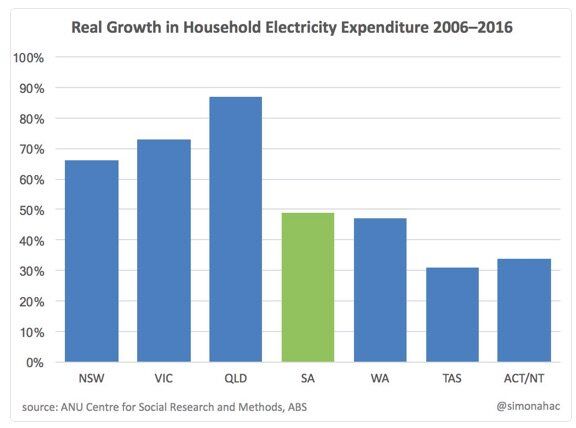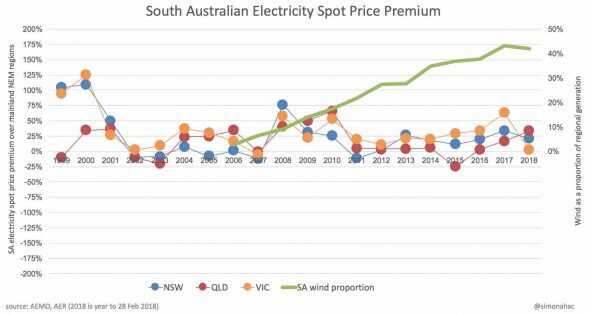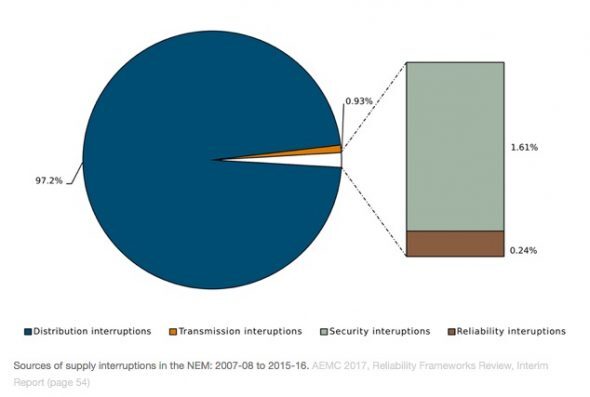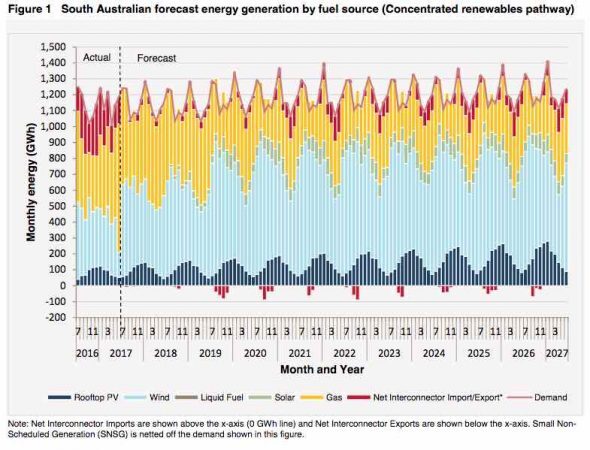The South Australia election is just two days away, and the renewable energy myths are flying thick and strong. In so far as the election will be decided by energy policy, we though it was opportune to have a look at these myths in detail.
Renewable energy has caused South Australia to have the highest prices in Australia.
If that’s the case, then how to explain the fact that South Australia has experienced much smaller rises than most other states over the past decade, the time span when renewables have been installed in the national grid, and in South Australia the most (now at 50 per cent wind and solar)
As this graph illustrates, South Australia’s price rises have been lower than those of the big three coal states – Victoria, Queensland and NSW
Why would that be? It’s because electricity prices are dictated by a whole host of factors – network costs, wholesale electricity costs and retail costs.
Renewable energy subsidies play only a very minor role in consumer bills, and as even the federal government admits, now that they are finally being built at scale, they will lower the cost of wholesale electricity, and more than offset the cost.
And that leads us to the second myth:
South Australia’s high electricity prices are a new phenomenon
No again. As this graph below shows, South Australia has had a price premium in wholesale markets over other states for most of the last two decades.
Why is this so? Well, it’s best explained by the local grid owner, SA Power Networks, which used to be known as ETSA, and looked at the causes of these high prices back in 2005 – way before the arrival of wind and solar:
ETSA said high prices were caused by a lack of good quality coal, reliance on expensive gas, limited connections with other states, and a unique demand profile caused by its mild climate contrasted by bursts of extreme heat that sends demand up more than 3-fold.
Add into this mix a very high uptake of air-conditioning (90 per cent of homes even in those days), lousy quality housing stock (no eaves, little insulation), and limited competition in the market, and there was the perfect recipe for high prices.
The high penetration of renewables means South Australia has the most unreliable grid
Over the last summer, with 50 per cent wind and solar, South Australia can lay claim to having the most reliable grid in the country. Unlike the previous summer, with severe weather events and mis-steps by the market operator, there were no major outages.
It reminds us that the overwhelming majority of outages in Australia – more than 97 per cent – are caused by faults in the local network, such as transformers failing or trees falling on wires. They have nothing to do with renewables. There is a really good explanation of this here.
What’s really exciting about South Australia’s grid is the introduction of Australia’s first, and the world’s biggest, utility scale lithium-ion battery at Hornsdale, which has demonstrated speed and versatility unseen before in the grid.
And, at the neighbouring wind farm, trials on providing security services such as FCAS have shown that wind turbines can deliver this service with more precision, and at significantly lower cost than conventional generation.
Labor’s 75 per cent renewable energy target is “reckless”
“Reckless” is a favourite line of the Coalition parties – both federal and state – and has been used against the Labor government’s newly announced “target” of 75 per cent renewables by 2025, along with a 25 per cent “storage” target, effectively equal to 750MW (one quarter of peak demand).
It’s fantastic that Jay Weatherill has guts and vision to lay such a plan on the table, and have a plan about how to manage it.
But, in fact, it’s actually not that ambitious, because it really only sums up the projects that have already been announced, much of which is in construction of near financial close.
The best way to illustrate this is to cite a report by the Australian Energy Market Operator, which in December produced an analysis that suggested South Australia could reach 73 per cent renewable energy by 202/21 and up to 80 per cent five years later.
This graph above is just an illustration of what an 80 per cent renewables grid might look like. And AEMO is confident that continued innovation – like the big battery and other storage – will ensure reliability and stability of the grid.
The high renewable share will drive business out of the state
Remember former prime minister Tony Abbott and his prediction that a carbon price would cause the steel city of Whyalla to become a ghost town. Were it not for renewables, it could still be.
One of the key things to note about the uptake of renewables in South Australia is the drive by customers to source wind and solar power to cover their own electricity needs.
At household level, South Australians have the highest uptake of rooftop solar in the country, and the world, as they seek to deal with those historically high electricity prices.
This capacity, already at more than 700MW, is likely to double over the next 10 years, and it is heartening to see political parties making sure that low income housing is not left out. The addition of battery storage will further reduce individual bills and broader costs.
Business is also a big buyer of renewable energy. Sanjeev Gupta is leading the way and intends to build more than 1,000MW of solar in the state, along with an even bigger big battery, and pumped hydro storage, to lower the cost of power for both the Whyalla steel works and other big users.
Indeed, Gupta says that without cheap green energy, the Whyalla steel works would not have a future, and it will be key to ensuring that Australia will remain a major manufacturer.
Compare Solar & Battery Quotes



